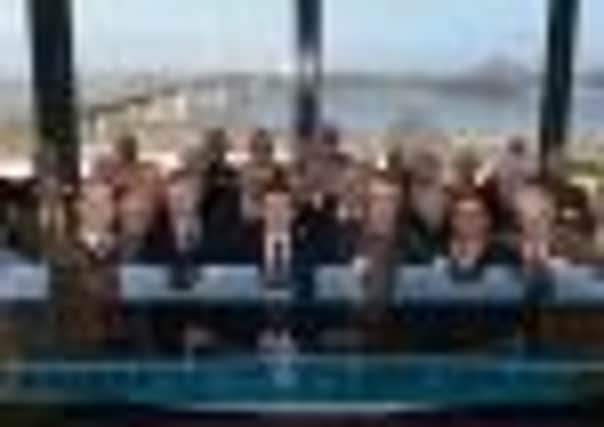Forth Bridge builders see new designs


The 70-year-old from Dunfermline relived memories of the risks taken by men building the Forth Road Bridge at a rare reunion yesterday of workers involved in creating one of Edinburgh’s great engineering masterpieces.
The men were invited back to the bridge by contractors, Forth Crossing Bridge Constructors (FCBC), in order to meet with members of the team responsible for the construction of the new Forth Replacement Crossing, set to open in 2016.
Advertisement
Hide AdAdvertisement
Hide AdMr Hay was just 19 – reputedly the youngest employee on the bridge – when he started working on the structure in 1961.
Describing one of his most vivid recollections, he said: “I was standing at the bottom of the south tower just staring into space waiting for the lift coming down to go up for a day’s work. I was looking out across the water.
“All I heard was the commotion and voices above and the next thing I saw the red blur. That was the colour of his jersey. That’s all you saw of him falling and going into the water.
“I ran with a life belt, but I couldn’t swim. He came up out of the water and started swimming towards the jetty. At the same time two guys had overtaken me, jumped into the water and pulled him out.
“There was practically nothing wrong with him.”
Advertisement
Hide AdAdvertisement
Hide AdOthers were not so lucky – seven workers died in the construction of the bridge, which was the longest suspension bridge span outside the United States when it was opened in September 1964.
Mr Hay climbed to the top of the 156m-high north main tower without a harness half a dozen times to replace aircraft warning lamps that kept going out.
And by his own admission, people needed a head for heights to complete the bridge’s most dangerous tasks.
“You kept super-fit going up and down the catwalks,” he said.
Advertisement
Hide AdAdvertisement
Hide Ad“The catwalks hung underneath the cables. They were 9ft wide. There were no ropes. You just did what you did. If you didn’t have a head for the heights, that was it.”
North Queensferry labourer Alan Bruce, 74, worked in the bridge’s reeling shed, feeding thousands of metres of wire on to giant drums to use for the structure.
He recalled the day both he and a co-worker missed the last train and ferry to the opposite shore and decided to cross the uncompleted bridge using the catwalk.
Mr Bruce said: “That’s how we got over. It took around an hour. I was all right, but when we got to the north side, I told my mate to check his underpants.”
Advertisement
Hide AdAdvertisement
Hide AdSouth Queensferry resident Alan Macdonald, 77, was a supervisor who worked for bridge designers Mott, Hay and Anderson.
He said the discovery of methane gas in the project’s south anchorage tunnel was among the many unexpected challenges during construction.
Mr Macdonald said: “There were no accidents thank goodness, apart from the one when we discovered the gas. The engineer and I saw bubbling coming up through the water in the bottom of the shaft. We collected a sample and took it back to the office.
“In our naïvety we thought it’d be a good idea to see if it was flammable. We dropped a match in this glass jar and we just about blew up the whole office.”
Advertisement
Hide AdAdvertisement
Hide AdMr Macdonald recalled witnessing the west cable swing the full width of the bridge one day in high winds.
He said: “The other alarming thing was when the towers were up before the cables went on, the towers were very flexible and there was considerable movement in them. The steel erectors were all sick – they couldn’t work up there because of motion sickness.”
About 30 former workmen gathered in South Queensferry for the briefing on the design and technical challenges involved in building the new £1.6 billion replacement crossing.
Transport Minister Keith Brown said he was confident the 21st century crossing would inspire future engineers in the same way as the two existing bridges.
Mr Macdonald described the design of the new bridge, due to be completed in 2016, as “magnificent”, adding: “It’ll be a unique vista.”